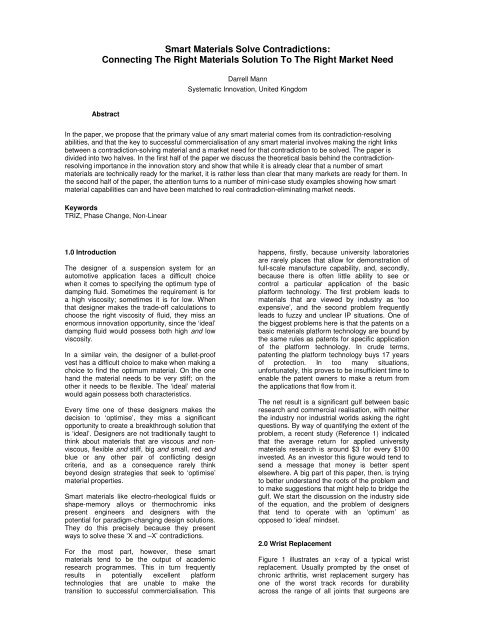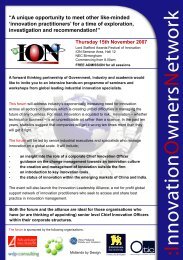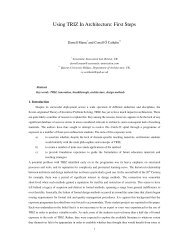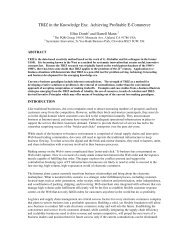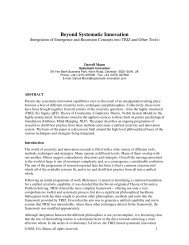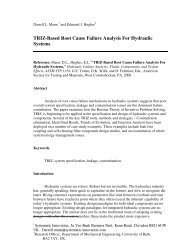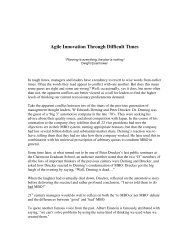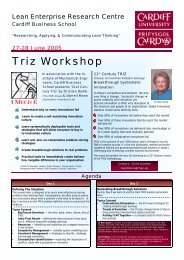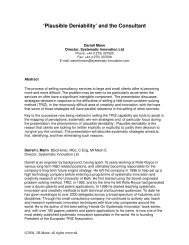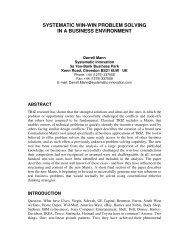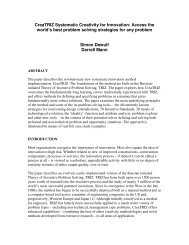Smart Materials Solve Contradictions - Systematic Innovation
Smart Materials Solve Contradictions - Systematic Innovation
Smart Materials Solve Contradictions - Systematic Innovation
Create successful ePaper yourself
Turn your PDF publications into a flip-book with our unique Google optimized e-Paper software.
<strong>Smart</strong> <strong>Materials</strong> <strong>Solve</strong> <strong>Contradictions</strong>:<br />
Connecting The Right <strong>Materials</strong> Solution To The Right Market Need<br />
Darrell Mann<br />
<strong>Systematic</strong> <strong>Innovation</strong>, United Kingdom<br />
Abstract<br />
In the paper, we propose that the primary value of any smart material comes from its contradiction-resolving<br />
abilities, and that the key to successful commercialisation of any smart material involves making the right links<br />
between a contradiction-solving material and a market need for that contradiction to be solved. The paper is<br />
divided into two halves. In the first half of the paper we discuss the theoretical basis behind the contradictionresolving<br />
importance in the innovation story and show that while it is already clear that a number of smart<br />
materials are technically ready for the market, it is rather less than clear that many markets are ready for them. In<br />
the second half of the paper, the attention turns to a number of mini-case study examples showing how smart<br />
material capabilities can and have been matched to real contradiction-eliminating market needs.<br />
Keywords<br />
TRIZ, Phase Change, Non-Linear<br />
1.0 Introduction<br />
The designer of a suspension system for an<br />
automotive application faces a difficult choice<br />
when it comes to specifying the optimum type of<br />
damping fluid. Sometimes the requirement is for<br />
a high viscosity; sometimes it is for low. When<br />
that designer makes the trade-off calculations to<br />
choose the right viscosity of fluid, they miss an<br />
enormous innovation opportunity, since the ‘ideal’<br />
damping fluid would possess both high and low<br />
viscosity.<br />
In a similar vein, the designer of a bullet-proof<br />
vest has a difficult choice to make when making a<br />
choice to find the optimum material. On the one<br />
hand the material needs to be very stiff; on the<br />
other it needs to be flexible. The ‘ideal’ material<br />
would again possess both characteristics.<br />
Every time one of these designers makes the<br />
decision to ‘optimise’, they miss a significant<br />
opportunity to create a breakthrough solution that<br />
is ‘ideal’. Designers are not traditionally taught to<br />
think about materials that are viscous and nonviscous,<br />
flexible and stiff, big and small, red and<br />
blue or any other pair of conflicting design<br />
criteria, and as a consequence rarely think<br />
beyond design strategies that seek to ‘optimise’<br />
material properties.<br />
<strong>Smart</strong> materials like electro-rheological fluids or<br />
shape-memory alloys or thermochromic inks<br />
present engineers and designers with the<br />
potential for paradigm-changing design solutions.<br />
They do this precisely because they present<br />
ways to solve these ‘X and –X’ contradictions.<br />
For the most part, however, these smart<br />
materials tend to be the output of academic<br />
research programmes. This in turn frequently<br />
results in potentially excellent platform<br />
technologies that are unable to make the<br />
transition to successful commercialisation. This<br />
happens, firstly, because university laboratories<br />
are rarely places that allow for demonstration of<br />
full-scale manufacture capability, and, secondly,<br />
because there is often little ability to see or<br />
control a particular application of the basic<br />
platform technology. The first problem leads to<br />
materials that are viewed by industry as ‘too<br />
expensive’, and the second problem frequently<br />
leads to fuzzy and unclear IP situations. One of<br />
the biggest problems here is that the patents on a<br />
basic materials platform technology are bound by<br />
the same rules as patents for specific application<br />
of the platform technology. In crude terms,<br />
patenting the platform technology buys 17 years<br />
of protection. In too many situations,<br />
unfortunately, this proves to be insufficient time to<br />
enable the patent owners to make a return from<br />
the applications that flow from it.<br />
The net result is a significant gulf between basic<br />
research and commercial realisation, with neither<br />
the industry nor industrial worlds asking the right<br />
questions. By way of quantifying the extent of the<br />
problem, a recent study (Reference 1) indicated<br />
that the average return for applied university<br />
materials research is around $3 for every $100<br />
invested. As an investor this figure would tend to<br />
send a message that money is better spent<br />
elsewhere. A big part of this paper, then, is trying<br />
to better understand the roots of the problem and<br />
to make suggestions that might help to bridge the<br />
gulf. We start the discussion on the industry side<br />
of the equation, and the problem of designers<br />
that tend to operate with an ‘optimum’ as<br />
opposed to ‘ideal’ mindset.<br />
2.0 Wrist Replacement<br />
Figure 1 illustrates an x-ray of a typical wrist<br />
replacement. Usually prompted by the onset of<br />
chronic arthritis, wrist replacement surgery has<br />
one of the worst track records for durability<br />
across the range of all joints that surgeons are
able to replace. Of the 30,000 or so wrist<br />
replacement operations carried out in the UK<br />
every year, almost half are replacementreplacements,<br />
where a surgeon is replacing a<br />
previous replacement that has somehow failed.<br />
big opportunity, then we might start making some<br />
innovation progress.<br />
Figure 2 illustrates what the contradiction-aware<br />
designer might see when looking at this wrist<br />
replacement problem:<br />
BECAUSE<br />
durable<br />
replacement<br />
joint<br />
compressive<br />
load<br />
spreading<br />
AND<br />
AND<br />
taper<br />
tensile<br />
loading<br />
no taper<br />
REQUIRES<br />
Figure 2: Wrist Replacement Joint Contradiction<br />
Figure 1: X-Ray Of Typical Wrist Replacement<br />
One of the main problems, as may be seen from<br />
the figure is that a lot of metal is required and<br />
there isn’t a lot of bone around to hold it. The<br />
problem is further complicated because, unlike,<br />
for example, hip replacements, wrists have to<br />
cope with a much wider range of loads. A hip<br />
joint spends nearly all of its time in compression,<br />
and when it is in tension, the load is limited to the<br />
weight of the leg. A wrist joint, on the other hand,<br />
experiences both tension and compression loads<br />
on a regular basis. In both cases, these loads<br />
can exceed the weight of a person’s whole body.<br />
Although wrist replacement joint engineers might<br />
not explicitly recognise it, they are caught in the<br />
middle of a challenging contradiction. The main<br />
problem area is the tapered pin inserted into the<br />
prepared end of the radius. When the joint is in<br />
compression (such as, say, when the patient is<br />
doing a push-up exercise), it is desirable to<br />
distribute the loads over as much of the taper as<br />
possible in order to minimise the likelihood of<br />
splintering the radius. Conversely when the joint<br />
is in tension (such as when the patient is doing a<br />
pull-up exercise), the taper is a bad thing,<br />
because it becomes very easy to dis-lodge the<br />
pin. One possible remedy to this problem, of<br />
course, is to tell the patient they shouldn’t do pullups<br />
or lift heavy objects anymore. Well, if that<br />
sounds like a pretty big compromise to expect the<br />
patient to make, it is ultimately not too far<br />
different from the compromise that the joint<br />
designer is also making.<br />
By recognising that a taper is a good idea for the<br />
compression case, an optimization-focused<br />
design strategy now sets about ‘optimizing’ the<br />
taper angle. If the designer was made aware that<br />
every time he or she started conducting<br />
sophisticated mathematical design calculations to<br />
find the optimum anything, they were missing a<br />
It is difficult for anyone – TRIZ-aware or<br />
otherwise – to contemplate a problem statement<br />
that says we want a design solution that has a<br />
taper and doesn’t have a taper. But, of course,<br />
that is exactly what we need to be thinking about<br />
if we are to create some kind of a breakthrough<br />
solution to the problem.<br />
One of the reasons the Figure 2 template<br />
(Reference 2) is useful, is that it offers the<br />
problem solver several contradiction resolution<br />
opportunities. Essentially each of the six lines in<br />
the picture represents a conflict or contradiction.<br />
Fail to solve one of them, and we still have five<br />
other possibilities. Were the designer to start with<br />
the ‘taper and no taper’ physical contradiction,<br />
they would immediately be presented with the<br />
usual separate-in-space, separate-in-time, etc<br />
strategies. Recently, these strategies have been<br />
complemented with a model that allows a<br />
problem solver to map the eligible separation<br />
strategies to the Inventive Principles that are<br />
most likely to help resolve the contradiction<br />
(Reference 3). The eventual model is illustrated<br />
in Figure 3:<br />
6, 8, 12, 33<br />
38, 39<br />
1, 28, 30<br />
31, 40<br />
CONDITION<br />
SPACE<br />
14, 17, 26, 29<br />
2, 3, 4<br />
5, 13, 22<br />
24, 25, 35<br />
11, 16,19<br />
20, 23<br />
7, 15, 27<br />
34, 37<br />
TIME<br />
2, 3, 4<br />
5, 13, 22<br />
24, 25, 35<br />
32, 36<br />
9, 10, 18, 21<br />
Figure 3: Mapping Physical Contradiction Resolution<br />
Strategies To The 40 Inventive Principles<br />
For this particular wrist replacement ‘taper-andno-taper’<br />
problem, all three of the time, space
and condition resolution strategies appear to be<br />
possible, and so the place to start looking for the<br />
most relevant Inventive Principles is at the region<br />
at the centre of the figure where all three regions<br />
intersect. What this means is that the most likely<br />
Principles to solve the wrist replacement problem<br />
– based on the thousands of problem solvers that<br />
have travelled a similar road before us – are 2, 3,<br />
4, 5, 13, 22, 25 and 35.<br />
Although it might not look or feel like it, Principle<br />
35 is the one that is trying to point problem<br />
solvers in the direction of smart material<br />
solutions. As discussed in Reference 4, Principle<br />
35 is simultaneously the most frequently<br />
recommended Inventive Principle and the one<br />
that is the least well applied by problem solvers.<br />
When applied to the ‘taper and no taper’ problem,<br />
it is easy to see why – simply telling a designer to<br />
‘change one of the design parameters’ is only<br />
slightly better than useless in the vast majority of<br />
cases. The missing piece in the jigsaw, or rather<br />
the biggest mis-interpretation of this Principle is<br />
that it is often viewed as a call to optimize ‘a<br />
parameter’, whereas in actual fact – since TRIZ is<br />
fundamentally not about optimization – it is a call<br />
for problem solvers to adjust parameters far<br />
enough that a non-linear shift in performance<br />
occurs. Figure 4 shows an example of the sort of<br />
way in which this strategy is most effectively<br />
applied.<br />
Principle 35A (and D) recommended direction<br />
Figure 4: Parameter Changes Across Phase-<br />
Boundaries<br />
Principle 35E<br />
recommended<br />
direction<br />
Having made the connection to non-linear shifts,<br />
it is necessary to work out what parameters are<br />
required to be shifted. A very good way to do this<br />
involves looking back at the Figure 2 template<br />
and examining ‘what changes’ between the two<br />
extremes of the contradiction. So, what changes<br />
between tension and compression in the wrist<br />
joint? Well, for one thing, the loading makes a<br />
switch from negative to positive. Strain also<br />
changes, and if strain is changing, so is the size<br />
of the hole in the bone. Stress is changing, which<br />
in turn means pressures are changing.<br />
Next, we need to explore if any of these changes<br />
are relatively different between the bone and the<br />
metal replacement joint. The reason for this is<br />
that any differences between the two materials<br />
may well cause problems. Having asked this<br />
question, it very quickly becomes apparent that<br />
there are many differences between the<br />
properties of bone and titanium. Not least of<br />
which is the fact that their stress-strain<br />
characteristics are very different. And not only<br />
different, but different in different ways as loading<br />
transitions from compression to tension.<br />
Ultimately, the differences reduce down to a<br />
difference in Poisson’s Ratio characteristics. In<br />
actual fact, the Poisson’s Ratio behavior under<br />
tension of bone is the exact opposite of that of<br />
titanium and other metals: ‘stretch’ bone and, at<br />
first, it gets fatter (i.e. it has a negative Poisson’s<br />
Ratio). Stretch titanium, on the other hand, and it<br />
gets thinner (i.e. it has a positive Poisson’s<br />
Ratio).<br />
So far so good. Having found a number of<br />
differences between what was there in the<br />
original healthy joint and what the surgeon is<br />
going to replace it with, and having picked up the<br />
idea of transitioning boundaries as a means of<br />
solving contradictions, we are in a position to<br />
conduct a targeted search for a ‘smart material’<br />
solution. And, ideally, one in this case, where<br />
under tension we achieve a negative Poisson’s<br />
Ratio, and under compression we achieve a zero<br />
or slightly positive Ratio.<br />
Are there solutions to this problem? Are there<br />
materials that are able to change their Poisson’s<br />
Ratio properties? It doesn’t sound too likely.<br />
Afterall, we can go to any materials textbook and<br />
discover that every material has a nice neat,<br />
single-value Poisson’s Ratio printed next to it.<br />
The answer, however, turns out to be yes,<br />
auxetic materials and/or structures, if<br />
appropriately configured, are amply able to do<br />
the job. Auxetic structures that are able to vary<br />
their Poisson’s Ratio properties according to<br />
different conditions have been observed for some<br />
time now. Alas, so far, no-one has made the<br />
connection between problem and potential<br />
solution. From the designer’s perspective, we<br />
propose here, it is because the wrong problem<br />
has been specified. More on that subject later. In<br />
the meantime, it will be useful to see whether it<br />
might be possible to generalize what has<br />
happened in this wrist replacement problem to all<br />
types of physical contradiction problems involving<br />
physical materials and objects:<br />
3.0 A Generalised Model<br />
The wrist replacement contradiction is by<br />
definition a mechanical problem. Any smart<br />
material solution to this problem requires the<br />
material to respond to in different ways to<br />
different conditions. The key word in that<br />
sentence is ‘respond’. The important question<br />
that goes with it is ‘what type of response does<br />
this situation require?’<br />
The next question that needs to be thought about<br />
is, what is changing that can act as a stimulus to<br />
create the desired response. The key word in that<br />
question being ‘stimulus’. In the case of the wrist<br />
replacement problem, the primary stimulus is<br />
load. Changing load, therefore, acts as a stimulus<br />
that prompts to trigger a changing Poisson’s<br />
Ratio response. In general terms, this is a
situation where we have a mechanical stimulus<br />
and are looking to trigger a mechanical response.<br />
The reason for thinking about the world in this<br />
kind of stimulus-response manner is that it allows<br />
us to make a very simple and effective way to<br />
classify smart material solutions. Table 1<br />
presents the results of arranging known smart<br />
materials in this way. Across the top of the table<br />
is a range of different kinds of response that a<br />
designer might wish to achieve. This is usually<br />
the place to start when looking at the table since<br />
it focuses on the outcome we are looking to<br />
achieve, and therefore the type of problem we<br />
are trying to solve. The ‘stimulus’ column down<br />
the left hand side of the table then prompts the<br />
user to think about what is changing (or what<br />
could be changed) in the system in order to<br />
trigger the desired response. The range of<br />
different classes of stimulus is intended to remind<br />
users that there are a number of possible<br />
options. In the wrist replacement problem, as in<br />
any situation where we are trying to create an<br />
‘ideal’ solution, the idea is to make use of a<br />
stimulus that is already present in the system.<br />
What the list reminds us, is that if there is no<br />
existing stimulus, there may be things we could<br />
add to the system.<br />
Table 1:List of known ‘intelligent’ or ‘smart’ resources:<br />
response→ electrical magnetic optical thermal mechanical chemical<br />
↓stimulus<br />
electrical<br />
magnetoelectronics,<br />
spinelectronics,<br />
spintronics<br />
electrochromic,<br />
electroluminescent,<br />
electro-optic,<br />
piezo-chromic,<br />
Kerr Effect,<br />
thermoelectric<br />
(Peltier)<br />
piezo-electric,<br />
electrostrictive<br />
electrorheological<br />
electro-kinetic<br />
electrolysis,<br />
electro-chemical,<br />
bio-electric,<br />
electro-migration<br />
magnetic<br />
optical<br />
thermal<br />
mechanical<br />
chemical<br />
magnetoelectronics,<br />
spin-electronics,<br />
spintronics<br />
Hall Effect<br />
photoconductive<br />
thermo-electric,<br />
superconductivity,<br />
Radiometer<br />
Effect<br />
pyro-electric<br />
piezo-electric,<br />
electrostrictive<br />
opto-magnetic<br />
Curie point<br />
rheopexic,<br />
auxetic,<br />
shearthinning,<br />
dilatants,<br />
non-<br />
Newtonian,<br />
pseudoplastic<br />
magnetochemical<br />
Pockel Effect<br />
magneto-optic,<br />
piezo-chromic<br />
thermochromic,<br />
thermoluminescent<br />
magnetostrictive<br />
mechanochromic,<br />
rheo-chromic<br />
colour-change,<br />
litmus,<br />
luminescence<br />
exo-thermic<br />
endothermic<br />
optical bistability<br />
photothermic<br />
optomechanical<br />
photoacoustic<br />
shapememory<br />
magnetothermal<br />
magnetostrictive,<br />
magnetorheological<br />
nuclear-magneticresonance,<br />
magneto-chemical<br />
photo-chemical,<br />
photosynthesis,<br />
photo-catalyst<br />
catalysis<br />
The best way to think of the table is as a list of keywords<br />
that can be used to instigate and guide a more<br />
detailed Internet or patent database search to find actual<br />
solutions. In the wrist replacement case, the box at the<br />
intersection between desired mechanical response and<br />
input mechanical stimulus indicates that auxetic<br />
materials are already an established solution in some<br />
applications. All of the entries in the Table – which we<br />
don’t claim to be comprehensive at this point in time,<br />
merely ‘a hopefully ‘useful start’ – comprise materials or<br />
materials systems where the kind of non-linear ‘phasechange’<br />
behaviour illustrated in Figure 4 has been<br />
achieved.<br />
4.0 Another Example<br />
Figure 5 illustrates an example of a rather more simple<br />
use of one of the smart materials identified in the table.<br />
The picture illustrates a ‘self-timing’ egg. The<br />
incorporated smart material solves a common problem<br />
with boiled eggs that we all like our eggs cooked a<br />
certain way, but we often get a result we weren’t<br />
expecting. The reason we get our eggs cooked<br />
incorrectly more often than not is that we all cook our<br />
eggs using an ‘optimization’ rather than ‘ideal’ mindset.<br />
That you probably don’t recognise this fact is a good<br />
indication of how difficult and insidious the optimizationversus-ideal<br />
shift can be.
Applying a bit of thermochromic ink to an egg-shell on<br />
the other hand merely needs the connection between<br />
the solution and a real problem to be made. If the<br />
designer gets the self-timing egg solution wrong, the<br />
consequence for the customer is an over-cooked egg.<br />
The joint designer, on the other hand put simply has the<br />
responsibility for the quality of a patient’s life sitting on<br />
his or her shoulders.<br />
Figure 5: ‘Self-Timing’ Egg<br />
We have all of us thought about the egg problem as an<br />
optimization problem because we all know how long we<br />
like our eggs cooked for. Alas, we have all remembered<br />
one (optimized) number (‘a four minute egg’), when of<br />
course, no two eggs are the same. What the self-timing<br />
egg solution does is effectively says, wouldn’t it be nice<br />
if my specific egg in my specific pan ‘tells me’ how<br />
cooked it is.<br />
The desired response, thinking to Table 1 is ‘tells me’.<br />
The table presents a number of possibilities here. Most<br />
likely the simplest of those possibilities, and certainly the<br />
choice made by the owners of the Figure 5 solution, is<br />
optical’. The next question, then, is what are the<br />
available stimuli that might trigger the desired response.<br />
Again, as with the wrist replacement problem, we need<br />
to look at what is changing in the system. Again as far<br />
as the owners of the solution were concerned, the<br />
simplest and most obvious change is in the temperature<br />
of the egg.<br />
There is a rather splendid quotation in John Naisbitt’s<br />
latest book (Reference 5), ‘don’t get so far ahead of the<br />
parade that no-one knows you’re in the parade<br />
anymore’. This quote gets right to the heart of the<br />
scientist’s dilemma in the world of smart materials. If the<br />
basic patent on a platform material technology protect<br />
your IP for 17 years (there are various tricks and<br />
strategies that can be applied to extend this period, but,<br />
for argument’s sake we will stay with this number since it<br />
doesn’t significantly alter the form or extent of the<br />
dilemma). The moment patents are filed, the clock is<br />
ticking in terms of commercialising and achieving a<br />
return on the investment that created the basic material.<br />
This means that unless applications that can be brought<br />
to market well inside the 17 year window, the basic<br />
material technology has limited if any value.<br />
Thermochromic inks are fundamentally simple and<br />
inexpensive, so their transition to market for a host of<br />
applications has been relatively simple. Despite many<br />
years of effort on auxetic materials, looking at the other<br />
end of the spectrum, there are still virtually no<br />
commercialised applications. Despite the often profound<br />
benefits they present to designers in a host of situations.<br />
Perhaps a good example of an organisation ‘getting it<br />
right’ is Dow Corning and the ‘Active Protection System’<br />
(APS) material solution spun out of research at Imperial<br />
College in London – Figure 6.<br />
Look up optical response from thermal stimulus in Table<br />
1, and the first answer in the list of possibilities is<br />
thermochromic. Which is precisely the solution adopted<br />
by the self-timing egg inventors. Or rather, almost (as<br />
ever, there is always a ‘yes, but’) because what makes<br />
the solution especially powerful is that it contains two<br />
subtly different thermochromic inks, each with a slightly<br />
different colour change trigger temperature. Hence, the<br />
word ‘soft’ (as shown in the Figure) is triggered at one<br />
temperature, and the word ‘hard’ is triggered at another,<br />
slightly higher temperature.<br />
5.0 From The Material Scientist’s Perspective<br />
In many ways the self-timing egg and the wrist<br />
replacement joint cases provide two ends of a spectrum<br />
as far as the materials scientist is concerned. In the wrist<br />
replacement case, the medical devices industry may<br />
well be guilty of defining the wrong problem, but one of<br />
the reasons they have been thinking in optimization<br />
rather than contradiction-solving terms is that they know<br />
how difficult it is to prove to the regulatory authorities<br />
that the solutions they are proposing are safe. Tweaking<br />
the shape of a titanium pin is a far easier thing to prove<br />
is safe than some new form or structure of titanium.<br />
Proving a new material is safe can involve several years<br />
of expensive validation testing.<br />
Figure 6: Dow-Corning Active Protection System<br />
APS is a material system that is flexible under low<br />
loading conditions (top-left part of the figure), but which<br />
becomes very stiff when subjected to a high impulse<br />
load (top right). In terms of Table 1, APS is, like the<br />
afore-mentioned auxetics, a material that achieves a<br />
mechanical response to a mechanical stimulus. The<br />
material is in fact a very elegant example of a shearthickening<br />
dilatant silicone coating.<br />
The material has a potential role to play in any situation<br />
where the ‘flexible and stiff’ contradiction is present.<br />
Having patented the basic platform technology the race<br />
is now on to find appropriate applications for the<br />
technology. Being aware of the contradiction being
solved has allowed the researchers to target a number<br />
of possible applications, the ultimate of which currently<br />
appears to be in things like bullet-proof vests.<br />
Proving that the material is suitable for such a<br />
demanding application, of course, requires time and<br />
significant resources. A very good strategy therefore is<br />
to identify shorter-term niche applications. A good<br />
example here – and perhaps a poster-child<br />
demonstration of just how hard the whole innovation<br />
timing task is – is the application in shin-pads for soccer<br />
players.<br />
Making a few thousand shin-guards doesn’t sound like a<br />
great reason for investing in the productionisation of the<br />
APS material, but what it may well do very admirably is<br />
provide a very high profile advertisement to let others in<br />
other fields know about the material. Plus it provides for<br />
the acquisition of real world data on the durability and<br />
effectiveness of the material – information that will be<br />
vital in supplying the necessary evidence that will be<br />
required by the regulatory bodies for the more<br />
challenging applications of the material.<br />
This author knows nothing of the actual Dow Corning<br />
strategy for APS. We do, however, work with a number<br />
of universities struggling with the issue of successfully<br />
commercialising their smart material platform technology<br />
research. There can never be a simple answer to the<br />
problem. But what can be said with certainty is that the<br />
problem almost always has a contradiction at its heart,<br />
and that, as a consequence, thanks to the TRIZ<br />
research, someone, somewhere will already have<br />
solved the contradiction. Figure 7, finally, highlights one<br />
of the frequently used solutions to the commercialisation<br />
contradiction:<br />
initial platform technology<br />
patent application<br />
initial high value niches…<br />
..support mainstream<br />
applications…<br />
17 years<br />
…and fund research to create<br />
new platform technology patents<br />
(which in turn extend the 17 year window)<br />
Figure 7: <strong>Smart</strong> Material <strong>Innovation</strong> Timing<br />
Everything in this picture stems from the 17 years that<br />
the original patents ‘buy’. (An immediate alternative that<br />
emerges here is for universities to consider not<br />
patenting, but rather keep their smart material<br />
formulations a trade-secret until such times as the first<br />
commercial possibilities are close to fruition.) In simple<br />
terms, if the patent game is going to be played, the aim<br />
is to generate revenues that pay for the research that in<br />
turn permit new and better platform patents to be<br />
constructed, which in turn, then keep moving the 17 year<br />
time window far enough into the future that the<br />
mainstream applications have sufficient time to get to<br />
the market and begin generating the revenues that will<br />
pay for the pensions of all involved.<br />
6.0 Putting It All Together<br />
The paper has discussed the gulf between smart<br />
material solutions and successful commercial<br />
exploitation. The gulf exists because both materials<br />
scientists and designers and engineers frequently come<br />
to the story with the wrong mindset.<br />
Designers and engineers need to begin thinking about<br />
contradiction-solving as a part of their job. They also<br />
need assistance to make it easy to find possible<br />
candidate solutions to the contradictions they find. Table<br />
1 of this paper is intended to act as a first step towards<br />
making a more direct connection between contradiction<br />
type and available solutions.<br />
For materials scientists, the challenge is more about<br />
managing the transition from basic material technology<br />
to successful commercialisation. As ever, all dilemmas<br />
are contradictions, and in turn all contradictions can be<br />
solved. The key to their resolution in the case of smart<br />
materials has a lot to do with finding sufficient high-value<br />
niche applications that will generate sufficient revenues<br />
to enable the research that will in turn open up the<br />
mainstream applications.<br />
7.0 References<br />
1) Graff, G.D., ‘Managing University And Government<br />
IP’, Commercialisation and Technology Transfer<br />
Seminar, ‘Leveraging IP For Wealth Creation’,<br />
Kuala Lumpur, December 2007.<br />
2) Mann, D.L., ‘Evaporating <strong>Contradictions</strong>: Physical<br />
And/Or Technical’, TRIZ Journal, March 2007.<br />
3) <strong>Systematic</strong> <strong>Innovation</strong> E-Zine, ‘Re-Thinking The<br />
Physical Contradiction Solution Strategies’, Issue<br />
76, July 2008.<br />
4) <strong>Systematic</strong> <strong>Innovation</strong> E-Zine, ‘Effective Use Of<br />
Principle 35’, Issue 58, January 2007.<br />
5) Naisbitt, J., ‘Mindset: Reset Your Thinking And See<br />
The Future’, Collins, 2007.<br />
www.systematic-innovation.com


